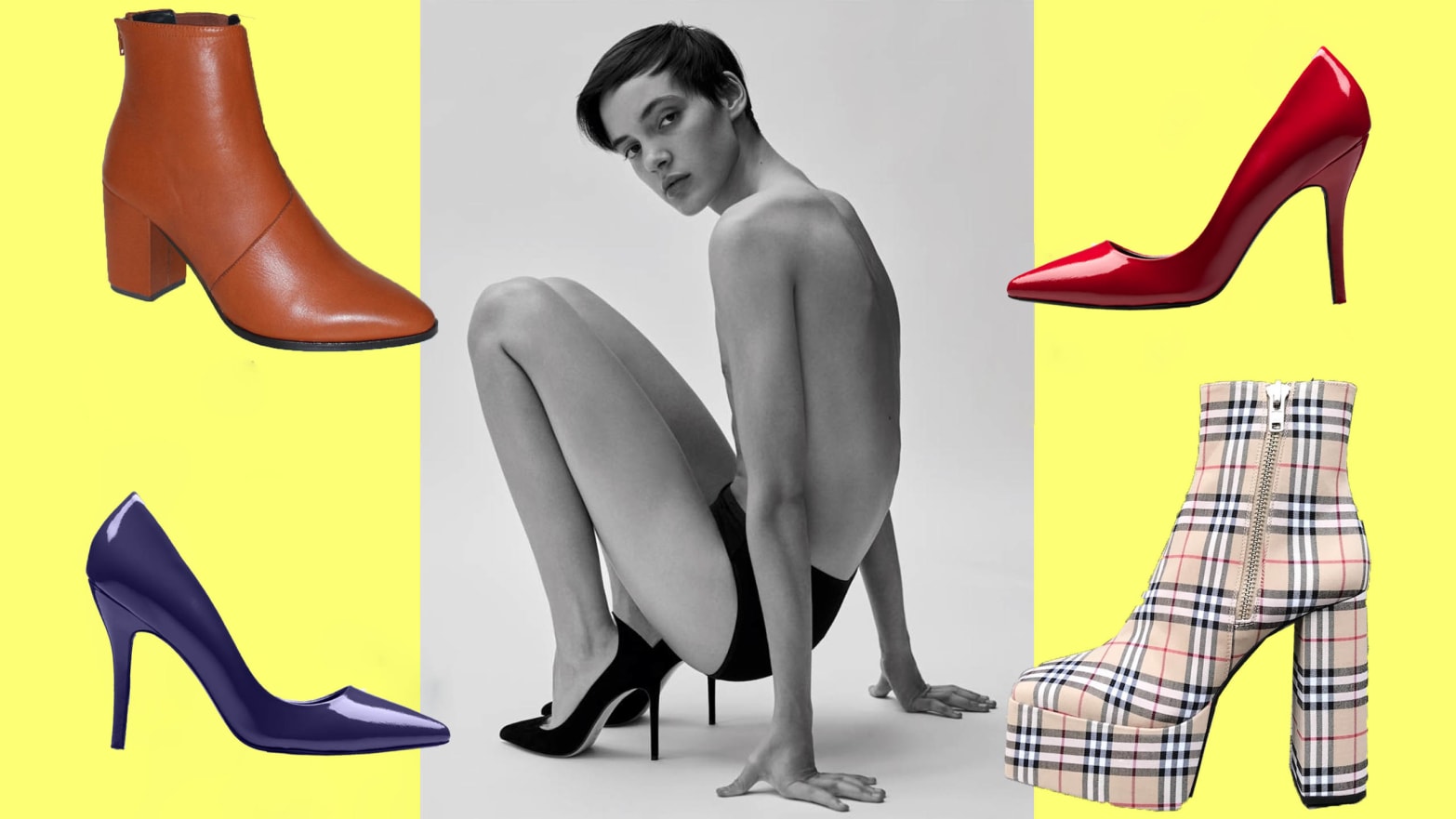Shaobo Han put on his first pair of heels at age 11. The pair wasn’t Han’s, exactly—he’d stolen them from his mother, to practice “prancing around the house when no one was around.” Han thought that boys weren’t supposed to wear heels, so he made sure to play with them in private.
“I have other male-presenting friends who have the same memory of trying on their mother’s clothes,” Han told The Daily Beast. “It’s fascinating that a collective memory exists. Even though nobody taught us how to wear heels, we all tried on our own.”
Years later, Han went to Forever21 to buy his first real pair of heels for $40. “I was lucky that my shoe size is a men’s eight, which is a women’s 10,” said Han. “Other people aren’t as fortunate. If they have larger feet than mine, it’s almost impossible to find something that fits.”
If a boy had larger feet, he could find stilettos at a drag store, but that resource would drastically limit any say he’d have in his own style. “Those shops cater to performers, so the shoes are much more outrageous,” Han said. At drag outlets you can find studded stilettos, leopard print pumps—but no subdued, day-to-day heels.
Han grew up to be a graphic designer, along the way running the femme footwear line Syro with business partner Henry Bae. The Brooklyn-based company sells heels and boots in men’s sizes 5-14. The styles are chic and trendy—plaid, patent, over-the-knee—but not gaudy à la Kinky Boots.
Whether a customer is male, trans, or non-binary, the mission of Syro is to promote femininity and encourage a fluid sense of style.
“We get emails where kids are saying how grateful they are to discover us, which is really heartwarming,” Han said. “They tell us that they’re wearing them to prom, or to a wedding. Those spaces are so gender-confirming so it’s nice to provide them a way to express themselves and challenge norms.”
But to a large extent, the mainstream fashion industry still relegates genderqueer, non-binary, or trans women back to the shameful, empty house burned in Han’s “collective memory.” Stilettos, especially, have never been kind to anyone with larger feet.
Women with larger feet have long been crafty when it comes to finding spike heels that fit. Regardless of their figure, they might shop a plus-size store such as Lane Bryant or Torrid, both of which carry up to a women’s size 13.
Last week, luxury Italian designer Francesco Russo launched a genderless line of stilettos available in Italian size 35 to 45. “It’s not a polemic, it’s not a political,” the designer told Vogue. “It’s simply how society is moving forward. I think it’s in our duty as people to produce product to respond to the world.”
As Rick Cataldo stopped for a smoke break outside of RuPaul's DragCon, the pro wrestler/drag queen (performance name: The Boy Diva), told The Daily Beast that he got his first pair of heels at Payless.
“That was the only store I could find that had big women’s sizes,” he said. Now, the self-professed “knock-off bitch” goes to high-end consignment stores to scope out size 10s and 11s.
“I have to say, Jessica Simpson is good with big heels,” Cataldo said. “And so is”—Cataldo took his shoe off, on the sidewalk, to check out the label on his black pumps—“DexFlex Comfort.” Pour one out for DexFlex.
With a lack of options, men who want to wear heels are left out of luck, trying to pack their feet into the closest fit. At DragCon, many queens teetered in stilettos at the event, but changed into sneakers for their commute home from the Javits Center.
Perhaps they switched shoes for comfort, or maybe because they didn't want to deal with stares on the subway—either way, it showed that for many, heels are still considered costume. The same person who may snap and "YASSS" watching a queen do a split in her Steve Maddens may look away, uncomfortable, when a transwoman walks to work in them.
Sensual as they may be, heels have a violent history. After all, stilettos take their name from the preferred knife of medieval assassins.
According to Edward Maeder, historian and founding director of the Bata Shoe Museum, one theory is that the first heels were worn by Persian calvarymen. “During the Middle Ages, there was a type of shoe that had a heel used for riding,” Maeder told The Daily Beast. However, the base was more of a raised platform than a true heel.
Louis XIV, who ruled France from 1643 to 1715, was perhaps the first heel influencer. His ornate, usually red shoes were delectably unsuitable for any activity that wasn’t showing off how cute the monarch thought his legs looked.
“Men wore knee breeches then, so you saw their calves,” Maeder explained. “If your heel is higher than the ball of your foot, your calf muscles are going to expand. The larger the calf, the sexier one was considered.”
Once men’s legs were hidden by trousers at the beginning of the 19th century, their heels disappeared, too. Impracticality once made heels so appealing to the upper echelons, but ornate, brightly colored clothing and accessories were soon dismissed as womanish, foppish, and effeminate.
A century later and a half later, the ‘60s saw the reemergence of block heels or platform boots for men, but stilettos were still reserved for women. “The only way you could get proper stilettos as a man was if you got them custom-made,” Maeder said. However, cross-dressing was illegal in 40 states for the majority of the 20th century. Even David Bowie, who delighted in gender-blurring fashion, stuck to wedges or platforms.
According to Maeder, the release of the 2005 British film Kinky Boots spurred a flurry of interest in drag culture. “There have always been drag queens, but Kinky Boots was key in bringing it into the mainstream,” Maeder said. RuPaul’s Drag Race premiered in 2009, and Kinky Boots became a Broadway musical in 2013.
Men, who could once only wear heels in the comfort of a locked bedroom, were free to slip on those bedazzled Weitzmans—if they could only fit into the damn things.
Cisgender women are encouraged to wear heels—if rom-com cliches are to be believed, the average girl basically lives in patent black stilettos. The same cannot be said for male-presenting humans.
Even in New York, a city where you can openly sob on the subway and be left alone, people will openly gawk over a man in heels. They’ll catcall. They’ll sneer. They’ll snap not-so-covert photos. “It’s really hard to have to choose expression over privacy or safety,” Han admitted.
Unwanted, sometimes dangerous, attention can stop men from dressing femme. “Males who experiment with heels generally do it much later in life than most women do,” Han said. “They’re 18, 19, 20 when they buy their first pair. It can be hard for them to feel comfortable in heels.”
Then again, no one is ever truly comfortable in heels.
“I’ve been in the middle of a desert on top of a rock, wearing stilettos for a photoshoot, and I’ve rolled my ankle,” stylist William Graper told The Daily Beast. “It fucking hurts, but I’m not about dressing for reality. I’m more about the fantasy.”
“Why do people wear spike heels? Because they can,” surmised Maeder. “It changes their stance and the way they walk. It emphasizes their buttocks, and it makes them feel more sensual and attractive. Your brain will turn off pain if you think you look good. Comfort is not in the equation.”
According to Graper, the rise in e-commerce has enabled brands to start catering to a wider selection of clientele.
Back in the day, the manager of a Steve Madden boutique may not have wanted to take a chance taking up precious shelf space with an outlying size 43. “Zara, Topshop, Aldo, Steve Madden, and even Jimmy Choo will all carry up to a 42 or 43, but only online,” Graper told The Daily Beast.
Graper, who identifies as male but plays with gender expression in his work, can’t tell if major brands are authentically embracing queerness, or simply exploiting it in their branding to make a profit.
“I see through clients hiring certain people because the optics of it looks really great,” he said. “But, if you’re hiring someone who’s gender-fluid or transgender, and giving them a platform, it’s good for everyone. The motive behind it may not always be pure, but it gives visibility. Growing up gay, I know that when you see someone who looks like you in an ad or magazine, you start to feel less crazy.”
That’s the best-case scenario. At worst, mainstream labels run the risk of tokenism. In 2016, Zara launched a controversial “ungendered” collection, which featured baggy sweatshirts and white t-shirts—lounge-wear staples long worn by either gender to little notice.
It was as if the mega retailer was screaming, “Look, we’re woke!” into a giant, megaphone, expecting a cookie. Instead, backlash was swift, with critics bemoaning Zara for using gender fluidity as a marketing ploy.
Such was the case when Chanel launched a “makeup for men” in August. The product range included foundation, lip balm, and eyebrow pencils—pieces that are all available in Chanel’s main “women’s” lineup. “Beauty is not a matter of gender, it is a matter of style,” reps for the company said in a statement to WWD, while simultaneously segregating its lip balm by gender.
Such appropriation hasn’t come for the stiletto world yet, but it could be just a matter of time before Big Fashion comes for men’s heels with dollar signs in its eyes.
Could such commercialization corrupt what small, queer-owned brands have done in promoting inclusivity for inclusivity’s sake?
Han’s “biggest fear” would be a Forever21-esque “male stiletto” collection. “We’re afraid that the mainstream industry sees us as a money opportunity. But it’s tricky, because at the same time, I would love for more heels to be accessible to everyone.”
Perhaps interest in men's heels is a long overdue validation for a group of people that have long been marginalized, but it might be too little, too late.
In a sneaker-crazed society, where The Washington Post reports that stilettos sales are down 12 percent in 2017, does anyone—regardless of gender expression—really want a heel, anyway?
"People are uncomfortable and unhappily politically, and it makes sense that they want to feed grounded," Graper mused. "When you're sky-high in a stiletto, you're not grounded."
There are many kinds of heels, but none come close to communicating drama quite like a stiletto can. It's what's kept the look in vogue for more than 60 years. Sure, they're comfortable, but kitten heels will never be as stylish as their taller cousins.
In Graper's words, "I don't love when people go for a shorter because it will be easier to walk in. It's like, shit or get off the pot."

